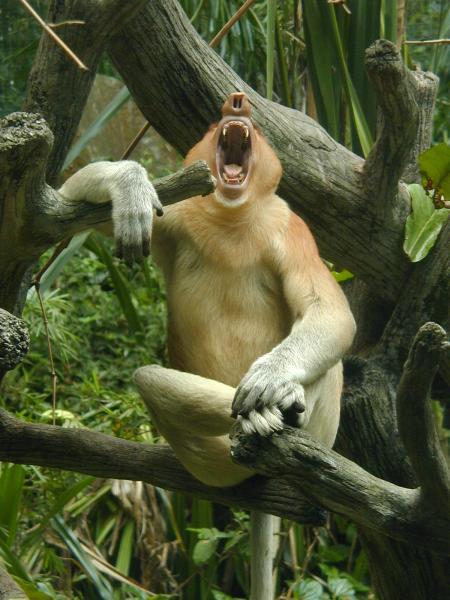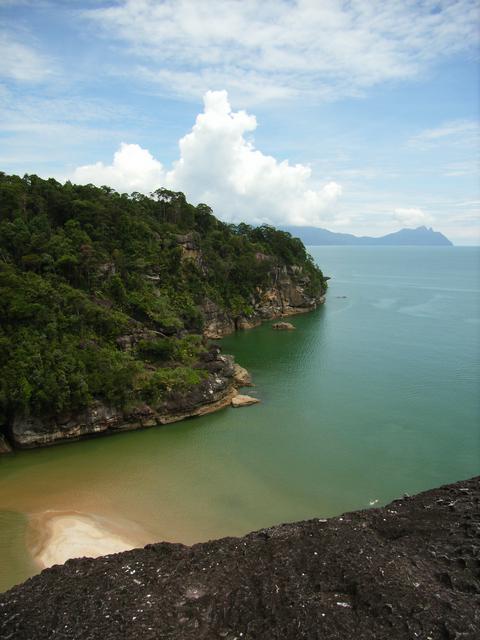
Bako National Park is in Sarawak, Malaysia, and is home to the bizarre, obscene-nosed proboscis monkey. It is well worth a visit if you are in the area.
Bako offers outstanding diversity of natural landscapes in a relatively small area. Its beautifully dense rainforests and stunning beaches are home to many flora and fauna including the rare proboscis monkey. Try and spot them during low tide as they forage in the exposed Mangrove tree swamps. There are 16 color-coded jungle trails as well as lodges for overnight stays - which you have to book early. On the high ground, look out for pitcher plants. And beware of the monkeys, they are very clever and compulsive thieves! (Don't forget to spot the boar!)
Bako is the oldest national park in Sarawak, established in 1957.
Bako consists of coastal cliffs and rolling hills, and boasts fine sandy beaches surrounded by jungle. Coastal erosion has produced interesting sea stacks and rock formations.
In particular, Bako is famous as a home to around 150 of the highly endangered proboscis monkey. Macaques are more fearless as well as more common, and thus much easier to spot. Another distinctive mammal indigenous to Borneo is the bearded boar. The common monitor lizard, growing up to 2 m long, is the largest of the park's many types of lizard; flying lizards may also sometimes be spotted
Wildlife is most active just before dusk, which means that an overnight stay may be needed to fully appreciate it.
Bako contains almost every type of vegetation to be found in Sarawak, including highly distinctive carnivourous plants. There are seven distinct types of ecosystem: beach vegetation, cliff vegetation, heath forest (kerangas), mangrove forest, mixed dipterocarp forest, grasslands vegetation (padang) and peat swamp forest
Bako enjoys sunny weather much of the year. Temperature is constant throughout the year, in the lowland range from a cool 23°C in the evening and early morning to 33°C under the shade during the day. But from late November to late January, the monsoon rain may spoil plans for an outing. The hottest months are usually from June to late August, when the tribal farmers do their slash-and-burn land clearing before planting their padi, this has been blamed for the haze that envelops the regions and may cause health hazards. But since the governments of both Malaysia and Indonesia have banned open burning, incidents of haze have been reduced somewhat.
As of June 2012, a new two-tier pricing system is in place. Foreigners have to pay doubled entrance fees, compared to Malay nationals.
Foreign Adult (single entry): RM20
Foreign Child/Senior (single entry): RM7
 A wide range of animal, bird and plant life including the Proboscis monkeys which come to the mangrove swamp to feed early evening. It's close to the lodging area where covered sheds are built, go there around 4PM, take a book and wait till they come. Seeing Proboscis and other species here is a lot easier and more comfortable than going on a safari. You just walk along an elevated wooden pathway, perhaps 10 minutes from where the boats land.
A wide range of animal, bird and plant life including the Proboscis monkeys which come to the mangrove swamp to feed early evening. It's close to the lodging area where covered sheds are built, go there around 4PM, take a book and wait till they come. Seeing Proboscis and other species here is a lot easier and more comfortable than going on a safari. You just walk along an elevated wooden pathway, perhaps 10 minutes from where the boats land.
You can also see the seastacks and a lots more.
Nighttime sightseeing hikes are sometimes led by park staff, and are also easier and more comfortable than ones done on a safari.
- Pulau Lakei. This small island has a superb white sand beach. The National Parks Department has a small guard house located on the island. Trips to the island can be arranged with your boatman. There are some mysterious rock paintings just a short walk from the beach
Pulau Lakei. This small island has a superb white sand beach. The National Parks Department has a small guard house located on the island. Trips to the island can be arranged with your boatman. There are some mysterious rock paintings just a short walk from the beach
Walks radiate from the centre offering a variety of difficulties in the heat and humidity and provide access to the habitats of the wide range of animal, bird and plant life in the park. The hikes are over some pretty rugged terrain for the most part, with lots of exposed tree roots and vegetation sometimes blocking trails that are less frequented.
- Paku trail. has the distinct advantage of being both relatively short and flat and offering one of the best opportunities to see the park's wildlife. It finishes at an attractive beach; one of the colonies of proboscis monkeys lives on the headland above
- Tajor trail. takes the visitor through varied terrain, including hilltops with extensive views, before finishing at a small but attractive waterfall, with calm pools that are safe for swimming in
- Limau trail. Continuing onwards from the Tajor train, the park's longest and most arduous trek ends on a beach, though by the time you've scrambled down to it, it may be too late to enjoy; it's possible to arrange to be picked up by boat from the beach to save your weary legs further punishment; ask the boatmen at the jetty if they could pick you up at Limau beach because sometimes the sea is too rough for them to reach Limau; please inform the park staff about your intention to do the Limau/Kruin trail as there have been cases where trekkers get lost or couldn't continue due to exhaustion
- Lintang trail. A circular loop taking the trekker through all the park's types of vegetation in half a day. Nice sightseeing.
With a little negotiation, a boatman will take you to nearby Pulau Lakai, a small island just off the mainland. The views on the way here are spectacular and it's special to have an island to yourself for a day.
- Kecil trail. A one and a half hour trek which ascends the forested hills overlooking Telok Assam, reaching a plateau covered in scrub vegetation, and continues along a sandy path lined with carnivorous pitcher plants, before reaching a cliff top with stunning views of the secluded bay below and the famous sea stack just offshore. A 10 minute descent through cliff vegetation brings you to one of the best beaches in the park.
Paku trail. has the distinct advantage of being both relatively short and flat and offering one of the best opportunities to see the park's wildlife. It finishes at an attractive beach; one of the colonies of proboscis monkeys lives on the headland above
Tajor trail. takes the visitor through varied terrain, including hilltops with extensive views, before finishing at a small but attractive waterfall, with calm pools that are safe for swimming in
Limau trail. Continuing onwards from the Tajor train, the park's longest and most arduous trek ends on a beach, though by the time you've scrambled down to it, it may be too late to enjoy; it's possible to arrange to be picked up by boat from the beach to save your weary legs further punishment; ask the boatmen at the jetty if they could pick you up at Limau beach because sometimes the sea is too rough for them to reach Limau; please inform the park staff about your intention to do the Limau/Kruin trail as there have been cases where trekkers get lost or couldn't continue due to exhaustion
Lintang trail. A circular loop taking the trekker through all the park's types of vegetation in half a day. Nice sightseeing.
Kecil trail. A one and a half hour trek which ascends the forested hills overlooking Telok Assam, reaching a plateau covered in scrub vegetation, and continues along a sandy path lined with carnivorous pitcher plants, before reaching a cliff top with stunning views of the secluded bay below and the famous sea stack just offshore. A 10 minute descent through cliff vegetation brings you to one of the best beaches in the park.
There is a local cafeteria that serves breakfast, lunch and dinner for RM5-10, cold can drinks for RM2.50, and 1.5 L water bottles for RM4.
There are no cooking facilities within the lodges.
Visitors to the park should ensure they carry large quantities of water with them; trekking in subtropical rainforest is thirsty work. If you're looking for nightlife you should probably arrange to be somewhere else in the evenings. The cafeteria has a variety of drinks including beer and soda.
Visitors are advised to stick to the marked trails, and visitors attempting the longer trails are required to register their arrival and itinerary at park headquarters. Read the estimated times the park suggests you allow for each trail and ensure that you allow enough time to return to park headquarters - or else arrange a meeting time at a selected beach with the boatman.
Virtually all of the trails are unsuitable for people suffering from limited mobility. Some parts of trails are negotiable only by wooden ladders and rickety bridges and boardwarks. Judging by the huge number of people passing through, these are better maintained than it might appear, but you'll still want to tread carefully
Saltwater crocodiles (Crocodylus porosus) may be found near river mouths and in mangrove swamps.
- Kuching, the regional capital and transport hub, is the nearest town of interest.
- Kubah National Park offers more hillside trekking options
- The Santubong Peninsular offers more sandy beaches and coastal jungle, with a much classier choice of accommodation
